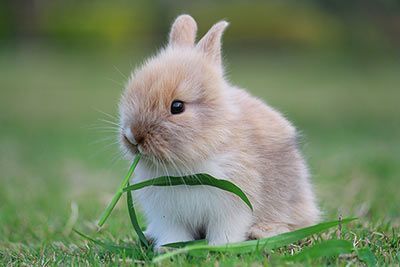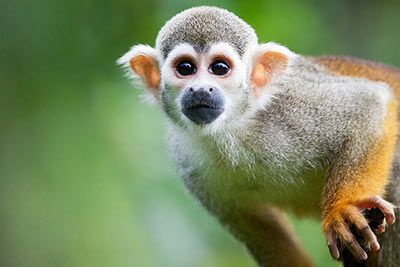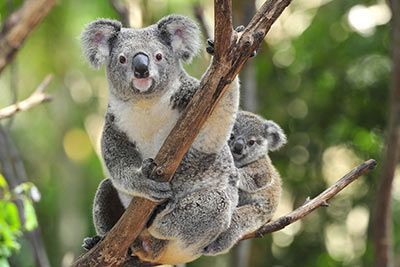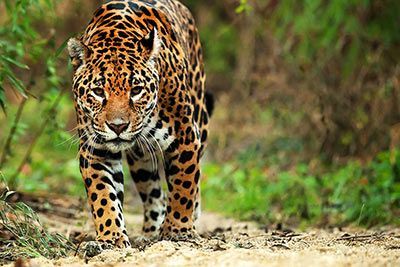Cow
Cow Facts
| Size | 54-60 inches (137-152 cm) |
| Speed | Up to 25 mph (40 km/h) |
| Weight | 1,100-2,640 pounds (500–1,200 kg) |
| Lifespan | 20 years |
| Food | Grass, herbs, clover |
| Predators | Bears, wolves |
| Habitat | Worldwide |
| Order | Even-toed ungulates |
| Family | Bovids |
| Scientific name | Bos primigenius taurus |
| Characteristics | Large hoofed animal, kept as a farm animal |
Main Characteristics
Cows are large and heavy hoofed animals. They're descended from the aurochs. Cows are kept as livestock animals to eat their meat, drink their milk and make leather out of their skin. They're as intelligent as dogs and they're also very sensitive. They maintain friendships and mourn lost or deceased family members.

Breeds
The most common breeds are Angus, German Holstein, Hereford, Texas Longhorn, Highland, Charolais, German Brown Swiss, Galloway, Limousin and Simmental.
Names
Actually, this animal profile should be titled “domestic cattle” instead of „cow“, but the term cow is used much more often. Here are the correct terms:
- Calf: Young animal
- Cow: Female cattle that has had one calf
- Bull, steer: Male cattle
- Ox: Castrated male cattle
Life Style
Cows are diurnal. They are very social and form herds of 20-30 animals. Within their herd maintain close friendships.
Anatomy and Appearance
Size and Weight
Bulls weigh 2,200-2,640 pounds (1,000-1,200 kg), cows only 1,100-1,760 pounds (500-800 kg).
Do Cows Have Four Stomachs?
Basically, it is just one stomach with four areas: rumen (fermentation chamber), reticulum (separates fermented from unfermented food), omasum (pressing and thickening the food) and abomasum (actual stomach). Grass is difficult to digest, so the animal requires these four compartments to effectively process it.
Horns
In most breeds, both male and female animals have horns. Only a few breeds such as Angus and Galloway cattle are polled. Dairy cows raised in barns often have their horns removed. The reason: Cows without horns take up less space. The less space they take up, the more cows can be kept in a stable.
Fur
Cows can be brown, black, white, spotted and piebald.

Diet
Food
Cows are herbivores. They feed on lush grass, herbs and clover. As farm animals they receive hay, straw, soy, grain and corn.
Water
Chewing a lot makes cows quite thirsty. This is why they drink up to 47 gallons (180 liters) of water in a day. If things have to happen quickly, 25 liters per minute.
Behavior
Why Do Cows Chew their Food Again?
Cows are ruminants. They chew their food about 30,000 times a day until it turns into a soft paste. It can be digested much better.
Senses and Abilities
Sense of Smell
Cows have an excellent sense of smell. The love of fresh, green, lush grass inspires the animals to go for a walk of 5 miles (8 km) (as long as the pasture is big enough). Cows can smell that far. S
Sense of Sight
A cow's second most important sense is the sense of sight. Even though their vision is actually quite blurry. However, they almost have a complete panoramic view of 330 degrees, which is why they can quickly recognize approaching enemies.
Why Does a Cow Need Horns Anyway?
Cows use their horns to communicate with other animals. They also help to keep a “cool head”. Heat is dissipated through the horns and the brain stays cooler. Most cows suffer from heat stress at temperatures above 77 degrees Fahrenheit (25 degrees Celsius).

Intelligence
Puzzles Are Fun
Cows can solve puzzles. For example, they press levers and buttons to get food and water. They understand the relation between cause and effect. This requires a lot of brains. The animals enjoy these kinds of puzzles and are happy when they complete tasks.
Facial Expressions
Cows communicate their feelings to fellow cows through facial expressions. It takes a lot of intelligence to interpret a facial expression correctly.
Best Friends
Cows have best friends. They spend a lot of time with them and are particularly loving towards them. They lick each other or nibble on each other to show their affection. They even recognize their best friends in photos.
Mourning for Family Members
Cows suffer terribly when separated from their family or friends.

Livestock Farming
Conditions
We like to believe that cows are allowed to graze comfortably on the meadow all year round. Is that actually the case? No. In Germany only 17%-34% are allowed to graze on pasture. In the state of Bavaria, tethering is also quite common. This means that the animals are tied up and have to stand in one place for almost their entire life.
Dehorning
Most dairy cows are kept indoors all year round. They're dehorned because their horns need space. and this way more cows can be kept in the stable. The University of Bern has found that calves continue to suffer from pain for months after dehorning.
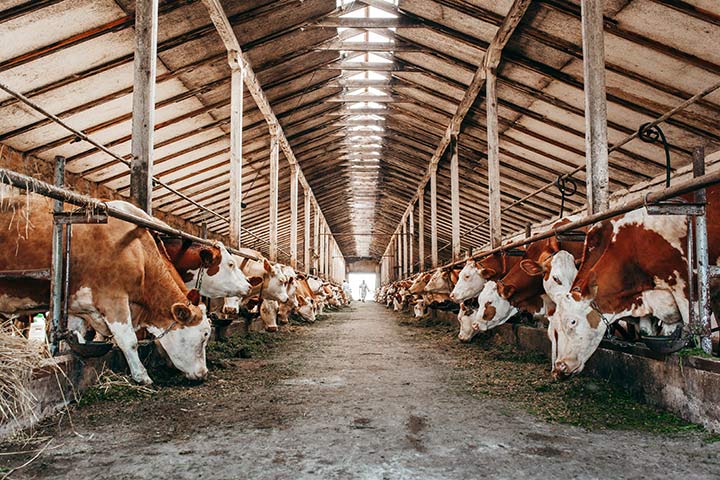
Dairy Products
Why We Can Drink Milk at All
The reason why we humans can consume (so much) milk and cheese is because their calves are taken away from their mothers shortly after birth. Actually the calf would drink the milk. Mother and calf suffer terribly from the separation. They usually don't see each other again.
Why Do We Even Drink Cow's Milk?
Humans started drinking milk around 7,500 years ago. Back then, many people died of malnutrition, so they ate and drank whatever was available. However, they couldn't tolerate it at that point. Even today, many people can't tolerate cow's milk. This is because they lack an enzyme that processes the lactose in milk (lactose intolerance). Scientific studies prove that cow's milk is not necessary for a healthy, balanced diet. Just so you know, humans are the only mammals that continue to drink mother's milk into adulthood.
Is Cow's Milk Healthy?
Scientific studies have been examining the health benefits of cow's milk for many decades. It is often highlighted that cow's milk contains nutrients such as protein, vitamins, and calcium. Scientific studies also show that cow's milk is not necessary for a healthy, balanced diet - because these nutrients are also found in plants (except for vitamin B12). Downsides are that cow milk can lead to increased cholesterol levels, promote diabetes, and contribute to cardiovascular diseases.
Life Expectancy
Cows usually can live up to 20 years. The oldest cow in the world was 48 years and 9 months old. Her name was Big Bertha. In livestock farming, calves only live for 18-22 weeks, beef cattle for 18-24 months and dairy cows for 4-5 years.
Enemies and Threats
Bears and wolves used to be natural enemies in Europe. Today the only enemy is man.
The Real Life of a Diary Cow
Cows have to stand in a cramped, smelly stable all year round. They have to give birth to a calf every year, which is immediately taken away from them. They're mainly fed special food that increases milk production. They wouldn't eat it in the wild. They also have to give lots of milk. At the beginning of the 20th century, a cow gave about 2.6 gallons (10 liters) a day. Today it is 10-13 gallons (40-50 liters). Cows can live up to 20 years. However, they suffer so much from diseases, lameness and reproductive problems that they're worthless for the dairy industry just after 4-5 years. Then, they'll be slaughtered.
Why Beef Cattle Suffer Terribly
Most beef cattle are kept in a cramped, smelly stable all year round - just like dairy cows. They're bred to maximize their weight and obtain as much meat as possible. That's why they get concentrated feed. They eat it because otherwise they would die of hunger. In the wild they would avoid concentrated feed. 200 years ago the slaughter weight was 352 pounds (160 kg), today it is 736 pounds (334 kg). The high weight puts a lot of strain on the joints and spine. As a result, they experience intense pain. Often, they also suffer unnecessarily while being transported to the slaughterhouse. It is common that they're subjected to additional and unnecessary mistreatment in slaughterhouses.
Importance for the Ecosystem
Our diet causes 26% of all greenhouse gases, which are responsible for our planet continuing to warm. Almost 60% of diet-related greenhouse gases are caused by animal products such as milk and meat. Habitats are destroyed for livestock farming, too. For example, forests in the Amazon region. Why? Because 70% of the soy grown worldwide is used for animal feed.

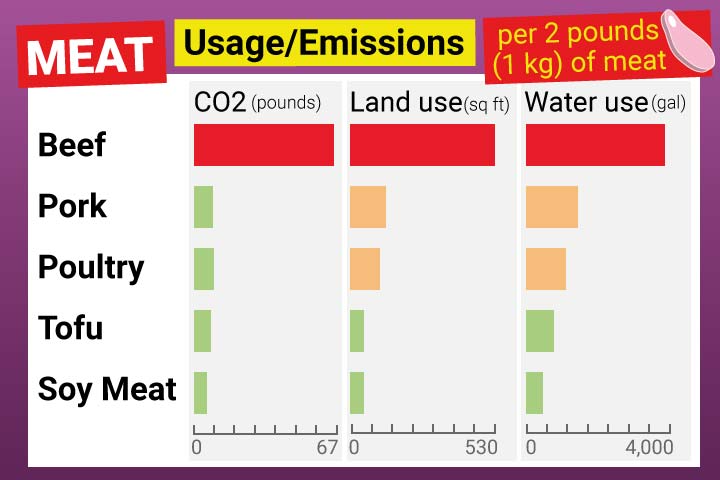
Reproduction
Cows usually give birth to a calf once a year. During the first few days after birth, the cow produces a special mother's milk that is not drinkable for us humans. After that, it is also drinkable for us. Cows are usually separated from their calves immediately after birth - after three days at the latest. How do you feel about it?
Records
The Tallest Cow
The tallest cow in the world was Blosom. She was 74.8 inches (190 cm) tall and a Holstein cow. The largest living bull in the world is a Brown Swiss named Tommy. It is 73.6 inches (187 cm) high (total height). The record is from December 2022.
Fun Facts
Regional Accents
"What d’ya say?" No, cows don’t speak any dialects we're familiar with. But their mooing actually differs from region to region.
Unable to Go Down Stairs
Cows can be easily led upstairs, but they would never walk downstairs. They aren't able to bend their legs properly.
They Don’t Fall Over
Sometimes cows have to be anaesthetized to get medical treatment or be transported. But they do not fall over then as we would do. Mostly they simply keep standing still. It’s alright as long as the doctor knows if the cow is wide awake or already drowsy.
In India They Are Considered Holy Animals
As farm animals cows produce milk, meat, and leather. But the Hindus in India worship the cow as a holy animal that must not be killed. The cow is seen as a mother or caretaker who sustains life.
The Cow Is Related To:
- Aurochs
- Bison
- European Bison
Animals in the Same Biome:
- Goat
- Sheep















